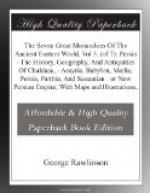It is impossible within the limits of the present work, and with the resources at the author’s command, to attempt a complete description of the Persian remains, or to vie with writers who had at their disposal all the modern means of illustration. By the liberality of a well-known authority on architecture, he is able to present his readers with certain general views of the most important structures; and he also enjoys the advantage of illustrating some of the most curious of the details with engravings from a set of photographs recently taken. These last have, it is believed, an accuracy beyond that of any drawings hitherto made, and will give a better idea than words could possibly do of the merit of the sculptures. With these helps, and with the addition of reduced copies from some of MM. Flandin and Coste’s plates, the author hopes to be able to make his account fairly intelligible, and to give his readers the opportunity of forming a tolerably correct judgment on the merit of the Persian art in comparison with that of Babylon and Assyria.
Persian architectural art displayed itself especially in two forms of building—the palace and the tomb. Temples were not perhaps unknown in Persia, though much of the worship may always have been in the open air; but temples, at least until the time of Artaxerxes Mnemon, were insignificant, and neither attracted the attention of contemporaries, nor were of such a character as to leave traces of themselves to after times. The palaces of the Persian kings, on the other hand, and the sepulchres which they prepared for themselves, are noticed by many ancient writers as objects of interest; and, notwithstanding certain doubts which have been raised in recent years, it seems tolerably certain that they are to be recognized in the two chief classes of ancient ruins which still exist in the country.




